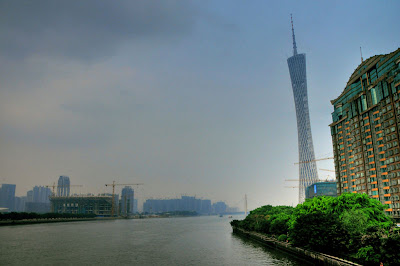Sunday, April 18, 2010
Frenetic pace of Guangzhou construction
Well, believe it or not, the pace of development in Guangzhou has gotten even hotter in the past five years. When I left, GZ had two subway lines. Five are now running with a sixth scheduled to start in May. A few more major interchanges and expressways were added making a trip through the city very fast. Before 2005, a taxi ride from the train station to my school area always cost around 50 RMB. Today you can get pretty much anywhere in the city for 35 RMB. It's a good thing I didn't try to haggle with the taxi driver when we got in. I'd have happily paid 50 RMB for the trip.
Much of the current construction is due to the 2010 Asian Games which will be held in GZ in November. In addition to a multitude of new venues, roadways and attractions being build specifically for that event, most of the city's buildings and neighborhoods are going through a massive renovation. I was in neighborhoods I used to regularly visit and could not recognize a thing - partly because of the new buildings that had popped up, but mostly because every other building was covered with scaffolding and green netting.
All the new construction is getting rid of neglected old neighborhoods and replacing them with shiny new ultra-modern glass and steel structures that dwarf most buildings in North America. The most recently completed building is the GZTV Tower which overtook Toronto's CN Tower as the world's tallest free-standing structure.
With all the new developments obliterating older neighborhoods, it is refreshing to see certain old structure being protected. The Chinese have a saying that "the new won't come unless you get rid of the old," and the country has lost a lot of historical structures because of that. The cultural revolution didn't help matters much either. Guangzhou has no shortage of ugly Mao-era that really need to be bulldozed, but it's also a 2,800-year-old city which should have a lot more historical structures than it does.
It was great to see that the 400-year-old Chigang Pagoda still standing in the shadow of the new GZTV Tower. Although the grounds to the pagoda are accessible, the area is not maintained and the building itself is not open to the public. It does, however, look like the place will be going through a major refurbishing as the area surround it is somewhat cordoned off and a building that was once a restaurant now only houses a caretaker for the area.
Another place we visited was Liu Rong Si, or the Six Banyan Pagoda Temple. Liu Rong Si was originally built in 537 AD, then rebuilt in 1097 and 1373 after being ravaged by fires. The current 1373 structure that still stands was restored in 1900 and is an extremely popular temple to visit - for locals and tourists alike. A Buddhist monastery is on the pagoda grounds and visitors can watch the services led by monks. When I last visited the temple in 2005, tourists were able to enter the pagoda and visit each of the nine floor. Tourist traffic must be taking its toll on the building as it is no longer open to visitors.
Meanwhile, in other parts of the city, new buildings are built to look old. In one subdivision, a replica of Beijing's Summer Palace Pagoda was built at the top of a mountain an houses a popular restaurant and tea house.
Guangzhou has long been an industrial centre of China that really didn't have much going for it as a tourist destination, nor did it have much visual appeal, architecturally speaking. That has changed dramatically over the past 10 years and Guangzhou's skyline easily rivals that of Shanghai, New York, Chicago or London.
On the down side, Guangzhou is still the buckle of China's industrial belt and the air quality is among the worst in the world.
The city may have a great skyline, but it can be difficult to see on most days.
Friday, April 9, 2010
Chen Clan Temple - Guangzhou China
 On our first full day in Guangzhou, one of my former students and her husband took us to one of my favorite spots in the city - Chen Jia Ci, or the Chen Clan Temple. It is also known as the Chen Family Academy....I don't really know why it has a couple of different English names, but "Academy" is a far more appropriate term to use that "Temple."
On our first full day in Guangzhou, one of my former students and her husband took us to one of my favorite spots in the city - Chen Jia Ci, or the Chen Clan Temple. It is also known as the Chen Family Academy....I don't really know why it has a couple of different English names, but "Academy" is a far more appropriate term to use that "Temple."The place was originally built as a family temple and a sanctuary for family members to study, but is now used as a traditional/folk art academy and is considered one of Guangzhou's top tourist attractions.
According to one of the official tourism sites, here's some history about the academy. "In the late of the Qing Dynasty (1644-1911), a man named Chen got the third place in the highest imperial examination and had conferred upon him a distinguished office title which made the Family Chen well-known. Later someone suggested that all the Chen's families raise money to build a temple to sacrifice to the ancestors and encourage their offspring likewise to study hard. Therefore, the temple was finished in 1894 with the money donated by Chen's families in 72 counties of Guangdong Province as well as some overseas members of Family Chen.
"The temple is a compound complex consisting of nine halls, six courtyards and nineteen buildings connected by corridors, all separated by walls from the outside world. A pair of stone drums in front of the entrance door, measuring 2.55 meters (about 8.36 feet) in height and two colored drawing pictures of door-god of four meters (about 13 feet) height are said to be the best in Guangdong.
"The compound was constructed in the traditional Chinese symmetrical style and the main hall, the Juxian Hall is in the center of the temple. Juxian Hall was once a place for clansmen to assemble before the establishment of the temple and now it is used as an ancestral hall. In front of the hall is a stone gazebo surrounded by stone balustrades. In the hall there is an exquisitely carved folding screen which is an excellent example of woodcarving."
The top photo is one of the many corridors in the complex that connects the different buildings. The bottom photo is one of the stone lions at the entry. The lions signify power and are there to keep evil and misfortune away.The temple was somewhat pillaged during the Cultural Revolution. Most of the contents were burned, but the structure itself miraculously escaped demolition. If my memory serves me correctly, the building were used as either a factory or a slaughterhouse during the cultural revolution and it fell into considerable disrepair. Since then, the all levels of government in China have been spending a lot to restore the place to its former glory. There is currently a very large construction project going on in front of the Academy that will give the place a massive courtyard-styled entry way. Both Wendy and I are looking forward to a return trip to Guangzhou to see the changes. We suspect that most of the construction should be finished by November when Guangzhou hosts the 2010 Asian Games.
For Wendy's take on the Chen Clan Temple, check out her blog.








